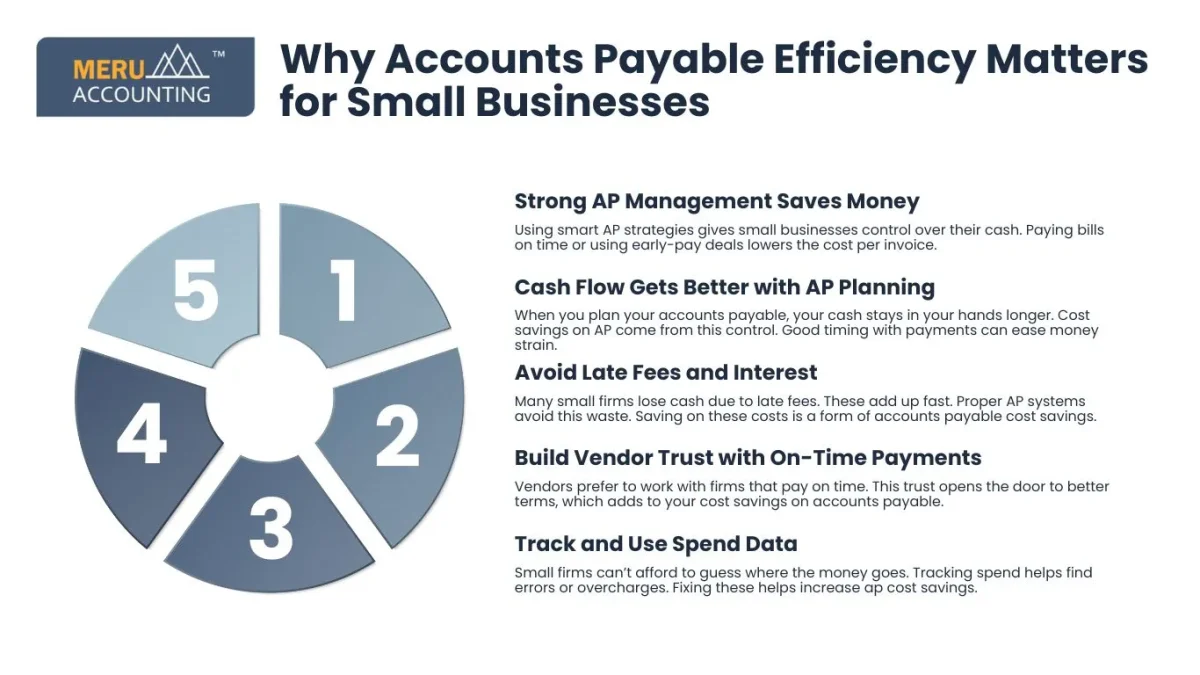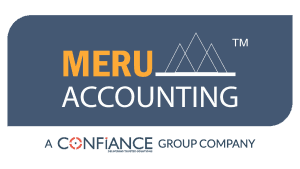Effective Accounts Payable Cost Savings Tactics for Small Businesses
Accounts payable cost savings tactics help small businesses control cash flow and reduce waste. Many firms lose money due to poor tracking, slow systems, or bad vendor terms. When a business focuses on cost-saving steps in accounts payable, it gains more control and can scale faster. Let’s explore how small businesses can apply strong accounts payable strategies and improve their profits.
Why Accounts Payable Efficiency Matters for Small Businesses
Keeping your accounts payable (AP) process in order is key to keeping your business steady. If you delay or miss payments, you pay more. If you pay early with no discount, you lose the cash you could use elsewhere.
1. Strong AP Management Saves Money
- Using smart AP strategies gives small businesses control over their cash. Paying bills on time or using early-pay deals lowers the cost per invoice.
2. Cash Flow Gets Better with AP Planning
- When you plan your accounts payable, your cash stays in your hands longer. Cost savings on AP come from this control. Good timing with payments can ease money strain.
3. Avoid Late Fees and Interest
- Many small firms lose cash due to late fees. These add up fast. Proper AP systems avoid this waste. Saving on these costs is a form of accounts payable cost savings.

4. Build Vendor Trust with On-Time Payments
- Vendors prefer to work with firms that pay on time. This trust opens the door to better terms, which adds to your cost savings on accounts payable.
5. Track and Use Spend Data
- Small firms can’t afford to guess where the money goes. Tracking spend helps find errors or overcharges. Fixing these helps increase ap cost savings.
Common Challenges That Drive Up Accounts Payable Costs
Many small businesses waste money due to gaps in their AP system. These common issues can stop cost savings on accounts payable and lead to a loss.
1. Manual Data Entry Causes Errors
- Manual systems lead to missed data, typos, and mistakes. Fixing these takes time and costs money.
2. Poor Approval Rules Delay Payments
- Without clear rules for approving bills, payments get stuck. This delay leads to late fees or bad vendor ratings.
3. Too Many Paper Invoices
- Relying on paper slows the AP process. It’s easy to misplace paper or miss due dates. This weakens your accounts payable strategies and adds cost.
4. Lack of Spend Oversight
- When no one checks what gets paid, you may overpay. You may also miss chances to ask for better terms. AP cost savings come when you watch every cent.
5. Vendor Terms Not Reviewed Often
- Some vendors offer early-pay discounts or better rates if you ask. But if no one reviews your contracts, you miss these deals. This hurts your accounts payable cost savings.
6. No Use of Tools or Software
- Small firms often avoid AP tools. However, those who use smart tools get better cost savings on AP. Manual methods slow growth.
Top Account Payable Strategies to Reduce Business Expenses
Small businesses can unlock big savings with the right accounts payable strategies. Each move should help reduce waste and keep cash in the firm.
1. Set Up Early Payment Discounts
- Many vendors offer a price cut if you pay early. A good AP setup lets you find and use these deals. This tactic gives true cost savings.
2. Standardize the Invoice Process
- Make all invoice steps the same—entry, approval, and payment. This helps avoid mistakes and keeps AP running smoothly. It also helps with cost savings on accounts payable.
3. Use a Two- or Three-Way Match System
- Match the invoice with the purchase order and receipt. This stops false bills or overcharges. This basic step supports your accounts payable strategies.
4. Review Vendor Contracts Often
- Go over contracts every few months. Ask for better terms if you’ve been a good client. This helps with long-term accounts payable cost savings.
5. Create a Clear Approval Chain
- Have fixed rules on who can approve bills. This avoids confusion and speeds up payments. A fast process leads to cost savings.
6. Train Staff in AP Best Practices
- Team members must know how to handle AP work. A trained staff reduces errors. Less error means more cost savings.
How to Achieve Long-Term Cost Savings on Accounts Payable
Saving money on AP should not be a one-time fix. You need ongoing steps that keep reducing costs over time. Long-term gains need smart planning.
1. Do Routine AP Audits
- Check your AP records often. Look for repeat errors or missed deals. Fixing these leads to steady cost savings on accounts payable.
2. Streamline AP Workflows
- Simplify each step from invoice to payment. The fewer the steps, the lower the risk of delay or error. This helps apply better AP strategies.
3. Track Metrics and KPIs
- Set clear numbers to measure your AP process. Track cost per invoice, days to pay, and late fees. These show how well your AP cost savings plan works.
4. Use Feedback from Vendors
- Ask vendors what slows your payment. Fixing these issues builds trust and may earn you better deals.
5. Centralize All AP Data
- Keep all records in one system. This helps you see trends and spot issues early. A clear view supports long-term cost savings on AP.
6. Stay Compliant with Tax Rules
- Good AP work helps with clean books. It also keeps you tax-ready. Staying compliant saves time and avoids fines.
Meru Accounting helps small businesses cut costs and grow with ease. Our expert team knows what works and how to apply strong accounts payable strategies for real results. We build custom plans based on your business type. We guide you in vendor talks. Our help often wins early-pay deals or better rates. This boosts your accounts payable cost savings over time.
FAQs
- What are the best accounts payable strategies for small businesses?
The best strategies include early payment discounts, using invoice matching, setting clear rules for approvals, and reviewing vendor contracts. - How can I achieve cost savings on accounts payable without hiring more staff?
You can save money by using automation tools, going paperless, and outsourcing your AP tasks. These tactics help reduce workload and bring quick cost savings. - Why do small businesses struggle with accounts payable cost savings?
Small businesses often rely on manual work, have unclear rules, and miss out on vendor deals. These issues block accounts payable cost savings. Fixing them with better systems and tools helps reduce AP costs fast. - How does AP automation lead to cost savings on accounts payable?
Automation cuts down manual entry, errors, and delays. It speeds up your AP process and gives better tracking. That means fewer late fees and better cash use, leading to true cost savings. - What tools or software help improve accounts payable strategies?
Tools like cloud-based invoice systems, approval trackers, and payment schedulers help improve AP strategies. These tools give small businesses a clear path to gain AP cost savings with less effort.








